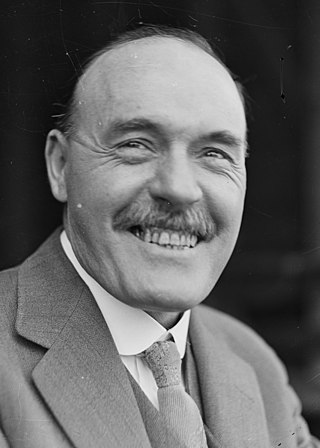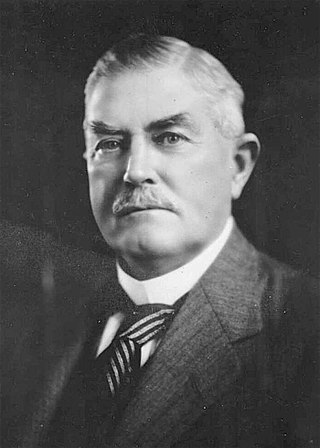
Arthur Hill Griffith was a politician, teacher and patent attorney in New South Wales, Australia. He was a member of the New South Wales Legislative Assembly from 1894 until 1917 and held a number of ministerial positions in the Government of New South Wales. He was a member of the Labor Party.
Members of the New South Wales Legislative Assembly who served in the 25th parliament of New South Wales held their seats from 1920 to 1922. They were elected at the 1920 state election on 20 March 1920. The Speaker was Daniel Levy with the exception of 13–20 December 1921 when he was replaced by Simon Hickey.
Members of the New South Wales Legislative Assembly who served in the 23rd parliament of New South Wales held their seats from 1913 to 1917. They were elected at the 1913 state election on 6 December 1913. The Speaker was Richard Meagher.
The Protestant Independent Labour Party, alternatively spelt Protestant Independent Labor and sometimes known as the Protestant Labour Party, was a minor Australian political party that operated mainly in New South Wales, Queensland and South Australia in the 1920s and 1930s. It was formed by Walter Skelton in July 1923 as the Protestant Independent Labour Party. who had stood for the New South Wales Legislative Assembly district of Newcastle at the 1922 election, campaigning as a Protestant Independent Labour candidate, in which he was elected first of five members, receiving 25.19% of the vote. In 1925 he was re-elected to the Assembly under the Protestant Labour label, as the second of five members, receiving 17.70% of the vote. The party stood candidates in 12 of the 24 districts however Skelton was the only one elected, with the next highest candidate receiving 5.10% of the district vote.

The 1925 New South Wales state election was held on 30 May 1925. This election was for all of the 90 seats in the 27th New South Wales Legislative Assembly and was conducted in multiple-member constituencies using the Hare Clark single transferable vote. This was the last election to use STV to elect the NSW Assembly.
Wilfred Joseph "Bill" Ratcliffe was an Australian politician. He was a Labor Party member of the New South Wales Legislative Assembly from 1922 until 1932, representing the districts of Botany (1922–1927), Alexandria (1927–1930) and Barwon (1930–1932). He was Secretary of Public Works and Minister for Railways for four months in 1927, during the last months of the first Lang government.

John Henry Cann was a New South Wales politician, Treasurer, and Minister of the Crown in the cabinets of James McGowen and William Holman.
Balmain, an electoral district of the Legislative Assembly in the Australian state of New South Wales, has had three incarnations since it was established in 1880. It expanded from 1 to 2 to 3 to 4 members before being abolished in 1894. It was re-established in 1904 returning 1 member until 1920. When multiple member constituencies were established using the Hare-Clark single transferable vote in 1920, Balmain returned 5 members. It had a single member from 1927 when the state returned to single member electorates. It was abolished in 1991 and largely replaced by Port Jackson which included the Sydney CBD. It was re-established in 2007 when Port Jackson was abolished.

William George Ashford was an Australian politician.

The Storey ministry was the 37th ministry of the New South Wales Government, and was led by the 20th Premier, John Storey.

The Fuller ministry (1921) or First Fuller ministry was the 39th ministry of the New South Wales Government, and was led by the 22nd Premier, Sir George Fuller. The ministry covers just seven hours during 20 December 1921, the shortest of any ministry in the history of self-government in the state.
Patrick Joseph Minahan, was an Irish-born Australian politician.

The 1891 New South Wales colonial election was held in the then colony of New South Wales between 17 June to 3 July 1891. This election was for all of the 141 seats in the New South Wales Legislative Assembly and it was conducted in 35 single-member constituencies, 20 2-member constituencies, 10 3-member constituencies and nine 4-member constituencies, all with a first past the post system. Part 1 of the Electoral Act of 1880 set the qualification for election on "every male subject of Her Majesty of the full age of twenty-one years and absolutely free being a natural born or naturalized subject". Seven seats were uncontested. The previous parliament of New South Wales was dissolved on 6 June 1891 by the Governor, The Earl of Jersey, on the advice of the Premier, Sir Henry Parkes.
The 1925 New South Wales state election was for 90 seats representing 24 electoral districts, with each district returning between 3 and 5 members. This was the third and final election in New South Wales that took place under a modified Hare-Clark voting system. The average number of enrolled voters per member was 14,690, ranging from Sturt (10,297) to Ryde (19,119).
The 1922 New South Wales state election was for 90 seats representing 24 electoral districts, with each district returning between 3 and 5 members. This was the second election in New South Wales that took place under a modified Hare-Clark voting system. The average number of enrolled voters per member was 13,785, ranging from Sturt (10,386) to Ryde (15,722).
The 1920 New South Wales state election was for 90 seats representing 24 electoral districts, with each district returning between 3 and 5 members. This was the first election in New South Wales that took place under a modified Hare-Clark voting system. The average number of enrolled voters per member was 12,805, ranging from Sturt (11,539) to Sydney (13,478).
Eastern Suburbs, an electoral district of the Legislative Assembly in the Australian state of New South Wales was created in 1920 and abolished in 1927.
Sturt, an electoral district of the Legislative Assembly in the Australian state of New South Wales, had two incarnations, from 1889 until 1968 and from 1971 until 1981.
A by-election was held for the New South Wales Legislative Assembly electorate of Sturt on 13 January 1917 following the resignation of John Cann who resigned to take the position of assistant commissioner of the New South Wales Government Railways. Cann had been elected as a Labor candidate at the 1913 election, however he was expelled from the party for voting against Labor's censure motion on 10 November 1916.










